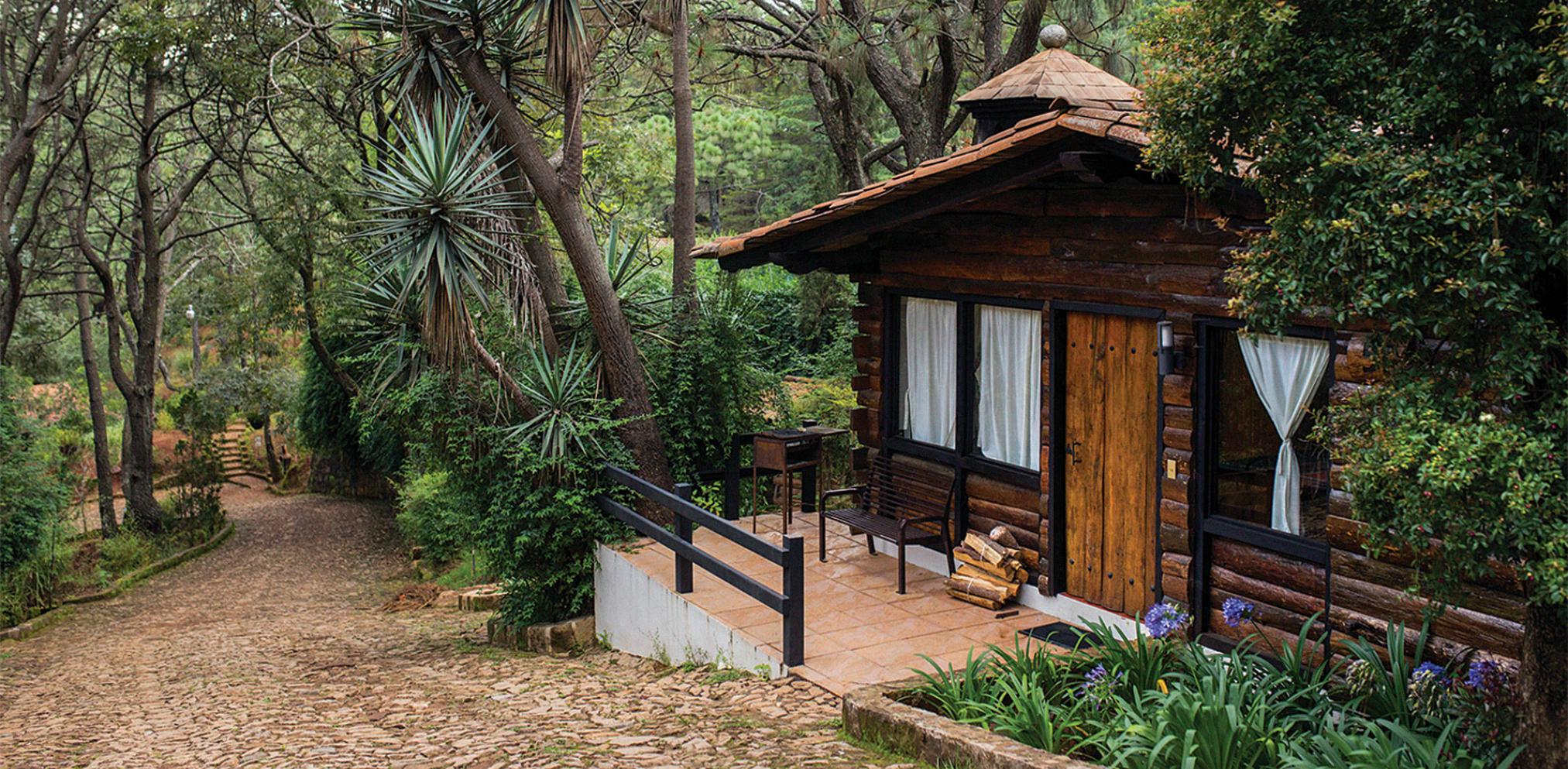GUADALAJARA SURROUNDINGS
Tourism in GUADALAJARA SURROUNDINGS
Near Guadalajara there are several of the most beautiful and interesting towns in the country, so these vacations you can take advantage of and visit those places that keep the true essence of Mexico in their streets.
Map of GUADALAJARA SURROUNDINGS
ZAPOPAN
Zapopan is the second most populous municipality in the state of Jalisco and ranks seventh in Mexico. The name Zapopan comes from the Nahuatl word “tzapotl” which means among sapote trees. It is known for its architecture, museums, premier shopping centers, major entertainment venues and for having some of the best hotels in the metropolitan area of Guadalajara. Zapopan also has natural outdoor attractions like El Diente and the Bosque de La Primavera (Forest of the Spring), among others.
Annually, a large procession in the image of Our Lady of the Conception’s honor takes place on the 12th of October. Starting at 6 am, the image is carried on the streets from the Guadalajara Cathedral to the Basilica of Zapopan. The streets, including the wide avenue of Manuel Avila Camacho in Zapopan proper, are packed with dancers, vendors selling traditional food and crafts and spectators. The Basilica of Zapopan is considered the third most important pilgrimage center in the country.
Tourist Attractions in Zapopan
Zapopan Arch
Made in quarry it is more than 20 meters high. It is hold by two rectangular columns with reliefs representing Zapopan’s foundation and present aspects.
Plaza de las Américas Juan Pablo II
It is located in front of the Basilica of Zapopan. It has a monumental gazebo and two large sculptures in bronze depicting the god and goddess of corn, done by Juan Méndez
Trepa
This is a place where you can practice and learn to climb. Schedule: Monday to Friday 8:00 to 13:30 and 16:00 to 22:00 hrs. Saturday 9:00 to 18:00 hrs.
Ixtepete o Iztepete
It is one of the most important archeological sites in western México. It displays a major pyramid.
Bosque de la Primavera (Forest of the Spring)
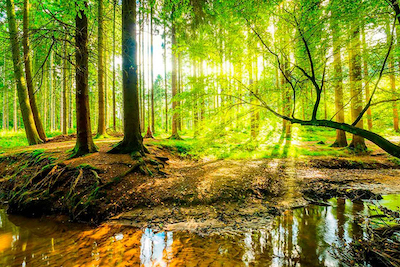
Located near Guadalajara, the forest covers 30,500 hectares over the Sierra de la Primavera. The forest area has 19 both fresh water and thermal springs, 1,000 species of plants, 106 species of mammals and 137 species of birds. There are a number of signaled hiking trails with signs pointing out interesting points and plants.
Etzatlán
This place is very important for its Ceremonial Center, called the “Arenal” with a series of shaft-chamber tombs.
Auditorio Telmex
Considered one of the most modern and functional venues in Latin America. Holds up to 11 000 500 spectators.
Parque y Zoológico Villa Fantasía (Park and Zoo)
It has an area of 15 thousand square meters. The zoo exhibits different species of animals, and a theater with live performances on weekends. It also feature a picnic area and a playground.
Centro Artesanal de Zapopan (Craft Center)
Place where you can find different types of handicrafts like carved stone and wrought iron.
Paseo Teopotzintl
A nice cobblestone walkway with shops and a wide variety of bars and restaurants.
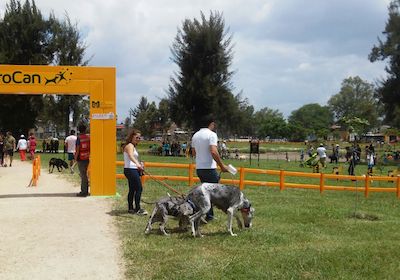
Parque Metropolitano (Metropolitan Park)
Represents one of the largest green space areas in Zapopan. It has 113 hectares of green areas, 4 running tracks and 3 foot ball courts.
Barranca del Río Santiago
A natural beauty also known as Oblatos Canyon. This canyon is 3.5 km wide, 700 meters deep and 200 km long.
Cerro del Diente
A natural area northeast of Zapopan with large rocks where mountain climbing, rock climbing and rappelling are practiced.
Andador 20 de Noviembre
The main walking corridor in Zapopan with bars, galleries and restaurants. On Saturdays, the artists and antique dealers display their wares for sale.
Churches in Zapopan
Basilica of Our Lady of Zapopan
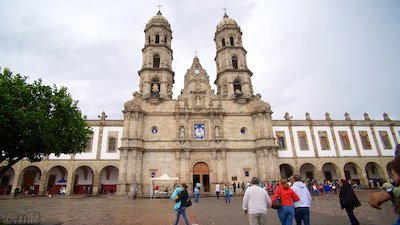
It is an architectural jewel, one of the oldest and richest buildings in Jalisco. It was built in the 17th century with a plateresque façade. Inside the church display beautiful altarpieces. It was completed in 1730, but its towers were renovated in 1734. A section of the basilica houses the Museum of the Virgin of Zapopan, where offerings left for the image can be seen as well as items that have been used for her worship over the centuries.
Calvary Chapel
The first Catholic mass in western Mexico was held in this modest chapel in 1530.
Santa Anita Parish
It dates back to 1732. It has a quarry façade with two towers. Next to the church is the cloister of the Franciscan convent with beautiful frescoes. In front is the Guadalupe Chapel.
San Pedro Apóstol Temple
It was finished in 1819 with a neoclassical style. The main façade is made out of quarry. There is an interesting 17th century painting from the famous painter Juan Correa.
Iglesia de la Parroquia de Atemajac
In front of Atemajac’s main is this Franciscan church built in 1718.
Templo de San Juan de Ocotán
An 17th century church located in Ocotlan. The façade shows the Coat of Arms of the Crown of Castile and Aragon.
TONALÁ
Its name comes from the Nahuatl word Tonallan which means “place where the sun rises”. This is a place full of culture and history and draws many visitors not just because of its proximity to Guadalajara, but also because of its rich history in Mexican pottery and handcrafted art. Tonalá has an enormous prestige in the art of making pottery, it is among the best in the world. A good porcertaje of its production is exported to destinations with a renowned ceramic tradition as Germany and Japan. Tonalá also work other crafts such as wrought iron, paper mache and blown glass, among others.
The City Council has organized free tours to artisan workshops. You can request information on tourism module located in the Plaza Cihualpilli. Surprise your senses with the magic of the crafts of this town, the birthplace of Jalisco pottery.
Tourist Attractions in Tonalá
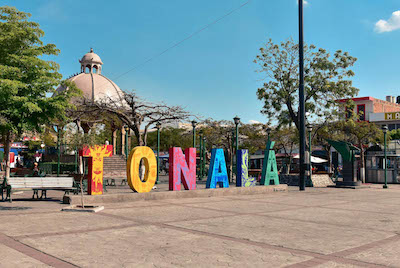
Plaza Cihualpilli
It has a lovely bandstand made in France in 1897. Municipal Palace –It houses beautiful burnished brick murals, as well as a unique clock in the shape of a sun. There are also glass cabinets with an exhibition of crafts.
Casa de los Artesanos (Artisan House)
This is a place to promote, exhibit and buy handcrafts from Tonala.
Cerro de la Reina
Natural viewpoint 2,500 meters high, where you can admire the city of Guadalajara.
Museums in Tonalá
National Ceramic Museum
A unique museum with an exhibition of pre-Hispanic, colonial and contemporary ceramic pieces. Schedule: Monday to Friday 10:00 to 17:00 hrs. Saturday and Sunday 10:00 to 15:00 hrs.
Museum of Archaeology and Popular Art Tonallan
Located in a 19th century house, it exhibits pre-Hispanic pieces, as well as paintings, sculpture and popular art. Monday to Friday 10:00 to 15:00 hrs.
Churches in Tonalá
Santiago Apóstol Parish
This is the second church built in the Atemajac Valley. The constuction was started by the Franciscans in 1661.
Templo de la Cruz Blanca
The evangelization of Atemajac’s Valley began on March 25th in 1530 in this chapel.
Santuario del Sagrado Corazón Temple
The old chapel of the Virgen de la Soledad Hospital, was rebuilt and became this temple since 1899.
Ermita de Guadalupe
A chapel made out of stone built in the Cerro de la Reina.
LAKE CHAPALA
Lake Chapala, the largest in Mexico, is a natural reservoir measuring 114 569 ha. It is situated between the states of Jalisco, which includes 86 per cent of the lake’s area, and Michoacan, which contains the remaining 14 per cent. The Lake is about 78 kilometers (50 miles) long from east to west with a maximum north-south width of about 20 kilometers (12.5 miles). It is located 48 km southeast from Guadalajara.
Chapala has become a tourist haven for the beauty of its landscapes, its typical kitchen, but mostly because the lake is surrounded by typical Mexican villages. In addition, the destination is nominated by National Geographic as the 2nd Best Climate in the World, temperatures here are pretty pleasant all year round, and -even better- with no extreme highs and lows.
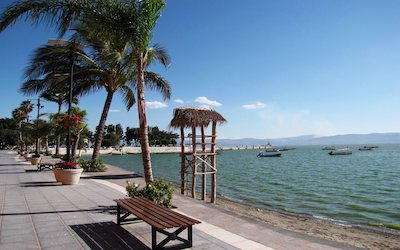
Lake Chapala offer endless opportunities for year round recreation and leisure activities for residents and visitors, such as: walking, hiking, sailing, water skiing, golf, tennis and horseback riding among others.
At Lakeside, you will find blocks of stalls, street markets, galleries, and workshops in the area. Antiques, furniture, tapestries, glassware, lamps, wrought-iron furniture, masks, pottery, jewelry, art and handcrafts of all kinds are sold here. In fact, the Lake Chapala area is fast becoming the region’s supplier of quality crafts.
Along the lake there are several villages like: Chapala, famous for the production of textiles; Ajijic with a rustic atmosphere and a unique community of artists; Chula Vista and San Juan Cosala, famous for its beautiful hot springs and spas.
In this picturesque lake there are two islands, one known as the Island of the Scorpions (for its shape), where besides the scenery, you can also enjoy mouthwatering local dishes and sing with the mariachis. And the second island known as Mezcala or Isla Presidio, is a national monument that boasts magnificent ruins of an old fort where Mexican forces fought the Spaniards.
Ajijic
Picturesque town of adobe houses with tile ridged ceilings and elegant country houses, cobbled streets, a beach with a pier and lots of handscrafts stores. There are beautiful lakeside views in Ajijic and one of the best weathers in the world.
Jocotepec
Jocotepec es una población del estado de Jalisco, que se ubica en la zona occidental del Lago de Chapala y cuenta con un gran legado de cultura e historia. Jocotepec aparece a unos 40 kilómetros de la ciudad de Guadalajara, en una zona de 1554 metros sobre el nivel del mar. La cercanía que tiene el Lago de Chapala de Jocotepec, hace que este último posea un grato microclima a lo largo de todo el año.
CIUDAD GUZMÁN (Zapotlán, el Grande)
Walk and enjoy its streets and squares, admiring its architectural and natural monuments and discover why it is one of the most beautiful places in the Jalisco geography.
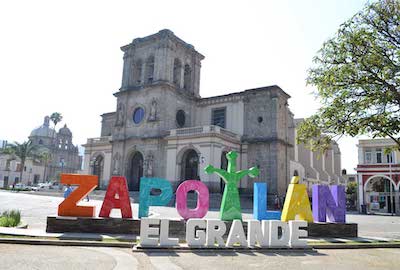
The quantity and quality of many of the creators, with a strong universal presence, who have emanated from this prodigal land, have earned them the proud adjective of Cradle of Great Artists, highlighting, among others, characters of the stature of José Clemente Orozco, Juan José Arreola and Consuelito Velásquez.
Live the emotion of knowing and enjoying the natural attractions that our municipality has such as: Nevado el Colima National Park, Las Peñas Ecological Park, Lake Zapotlán. In these places you can observe beautiful landscapes, do adventure sports and experience contact with nature through activities such as hiking, camping, mountaineering, bird watching, etc.
Breathe in the smells of its rich gastronomy and accompany your tasting with the fruity punches, the walnut levers and the exquisite pastries.
Due to its geographical location, Ciudad Guzmán is the municipal seat of Zapotlán el Grande, Jalisco; It is considered one of the main cities of the State due to its feasibility as a pole of Industrial, Commercial and Tourist development.
It is located 124 km from Guadalajara, the second most important city in the country and 47 minutes from the City of Colima, capital of the State of the same name and 110 minutes from Manzanillo, the port of entry and exit to the markets of the Pacific basin.
Tourist Attractions in CIUDAD GUZMÁN
City Hall
Avant-garde construction, built in 1912, with Don Francisco Villanueva being municipal president. It was originally on one level, in reminiscent Art Deco style.
Palace of the Olotes
Monumental building built in the 20th century. Preserves an eclectic architectural style. Around this property there is a legend that it was built by its owner, Don Salvador Ochoa Mendoza with the sale of the ears of corn from the one-year corn harvest, hence the peculiar name by which it is known in the community.
Sandoval Portal
It is intended to create and strengthen infrastructure and promote regional economic growth and its consequent correlation with the State.
Diaz House and Portal
Finca built around 1883, in the neo-Gothic style, attributed to the builder of Zapotlán, D. Hermenegildo Lepe. Today it houses a restaurant, whose name stands for the most typical part of the estate, which are the Moorish portals inside.
Old Vergara House
Its architectural style is eclectic with regionalist tendencies and dates from the second half of the 19th century.
Old Railway Station
Built at the beginning of the last century and personally inaugurated by General Porfirio Díaz around 1908; in your enviroment; Revolutionaries, Carrancistas and Cristeros made their concentration camps having it as the center of their strategies and operations.
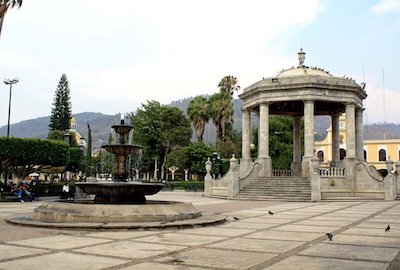
Main Square
Main Square of Zapotlán el Grande, allows you to observe the grace of the facades of the most important buildings, whether civil or religious.
Municipal market
Its construction began in 1913, with Mr. Francisco Villanueva Guerra being municipal president. Originally it was on one floor in Artdeco style, it was opened to the public in 1939, and in 1970 a high floor with avant-garde trends was added, in 1994 it was remodeled, recovering its old facade.
Hotel Zapotlan
It is one of the best known buildings of historical significance in Ciudad Guzmán; This was the place where Venustiano Carranza came to rest in 1913, still the stories and chronicles give an account of his visit and how he was received by Guillermo Jiménez with the phrase: “Welcome to Zapotlán, Blue Knight of Hope …” .
Municipal cemetery
The hundred-year-old Guzman necropolis moves towards the western part of the city, where beautiful chapels and neat crosses rise, intermingling with green trees and slender palm trees, which rustle before the inevitable swaying of the wind.
Churches in CIUDAD GUZMÁN
Cathedral of Saint Mary of the Assumption
Main religious site in the region. The first stone of this magnificent neoclassical construction was laid on May 27, 1866, and it was put into public service on October 8, 1900.
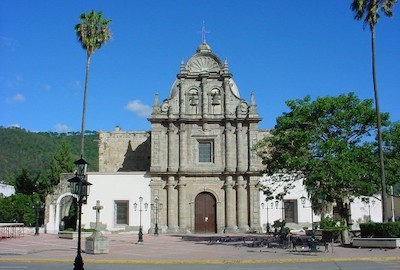
El Sagrario Temple
In Herrerian style, it was built in the 16th century with indigenous labor guided by Fray Juan de Padilla and paid for with the moral and economic help of the first viceroy of the new Spain, Don Antonio de Mendoza.
Third Order Temple
Enclosure that evokes the elegance and austerity of the Franciscan order, in Herrerian style with classicist reminiscences, this construction dates from 1713 and was built in materials such as adobe, stone and wood.
San Antonio de Padua Parish
An architectural jewel conceived during the second half of the 19th century and inspired by the great European Gothic cathedrals. Neo-Gothic in style, the first stone was laid on June 14, 1886, and was completed on September 8, 1928.
Sanctuary of the Virgin of Guadalupe
Beautiful eclectic building. A great earthquake, which occurred on June 7, 1911, destroyed the old Shrine of Our Lady of the Sacred Heart, and in its place was built that of Guadalupe.
San Pedro Temple
Magnificent neoclassical construction, which rises gracefully dominating the southern landscape of the urban area, whose first stone was deposited by the Bishop of Colima, Ignacio de Alba in the year 1944.
Ecotourism in CIUDAD GUZMÁN
Ecological Park “Las Peñas”
Rocky skirt to the east of the city, the ruins of a wheat flour mill, built in the middle of the 18th century, can still be seen. The beautiful natural environment today is an ecological park, equipped with terraces, grills, parking, toilets and a good number of trees, ideal for families to find recreation for hours in the shade of the pine forests scattered in the area.
From the heights of Las Peñas, where the rocks known as Los Compadres, overlook the Zapotlán valley, ideal for hiking, natural rock climbing, rappelling and bird watching.
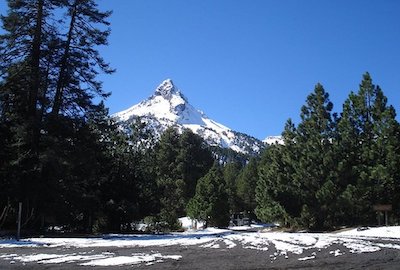
El Nevado de Colima National Park
The most important and prominent reference point in the southern region of Jalisco considered among the 60 most important mountains as a water factory, also considered as a Priority Land Region and Area of Importance for Bird Conservation. It reaches more than 4 thousand meters above sea level.
In the months of December, January and February, when its peak usually has snow, the main attraction for national and foreign visitors, who find a fascinating landscape composed of an exuberant and peculiar flora and fauna. It is worth mentioning that in the Nevado el Colima National Park it is the scene of impressive panoramic views, observation of endemic flora and fauna and the ideal mountain for practicing ecotourism and adventure sports.
Zapotlán Lagoon
Considered a Ramsar wetland site, Lake Zapotlán is one of the main natural attractions of the municipality, due to the concentration of unique flora and fauna species in the region.
This lake has been the scene of multiple sports and leisure activities, as well as being an important economic hub for the population itself, which uses fish for consumption and tule plants for making handicrafts and household utensils.
Ecotourism Route Sierra del Tigre
Magical and incomparable place where nature merges with the aromas of the forest and the sounds of birds and birds, streams and waterfalls, which together with its communities and its people make the Sierra del Tigre a special place
Sierra del Halo Region and Volcanoes
From the south-southeast of Jalisco the majestic Sierra del Halo rises. Imposing region characterized by a large area of more than 240,000 thousand hectares of forest and a beautiful panoramic view of this Mexican Eden.
LOS ALTOS DE JALISCO
They constitute a set of highlands, a great plateau that rises more or less uniformly, up to 2,000m. The Aguascalientes River gives rise to the main current of the Verde River and in its basin are the Los Altos de Jalisco, which are the continuation towards the west of the high and undulating lands of the north of the Bajío, from which they are barely distinguished by being a little drier. The terrain is mostly undulating and stony. It is densely sparsely populated, has a large number of medium and small towns.
As its name says, the Altos de Jalisco region is located at the top of the mountains that rises town to town surrounded by a magnificent forest and a blue sky away from the busy cities.
This area stands out for its religious tourism. In the distance you can see the domes of the temples of each of the municipalities, which have impressive religious buildings of which San Juan de los Lagos stands out, which has a large number of followers not only from that municipality, as well as neighboring towns, faithful of the republic and the world.
The colonial history, the pre-Hispanic traditions, the Catholic faith, its haciendas, large houses and the warmth of the people of the highlands of Jalisco make it a unique destination, it is a mosaic of possibilities, colors and unique experiences.
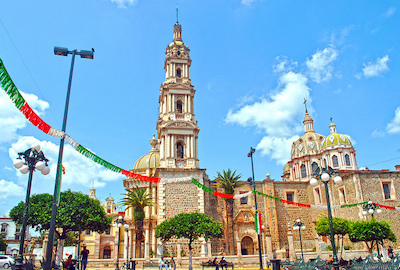
Tepatitlan
The tour begins in this town in the southern region, known as “the capital of Los Altos.” Walking through its streets is a real joy, starting from the magnificent ornamental smithy kiosk in the Plaza de Armas and through the French-style buildings.
Here a visit to the Parroquia de San Francisco and the Sanctuary of the Lord of Mercy, a neoclassical church and pink quarry is essential. If you like small museums, we suggest you take a tour of the charming City Museum and the Cactus Museum, which houses more than 150 species of this family of plants.
Arandas
This town in the Altos de Jalisco is affectionately called “Parrandas”. And the thing is that the party and tequila, as inseparable as the families that inhabit it, are the norm here.
The Temple of San José Obrero, with its giant bell, is a must. A stopover at one of the many taco stands is also necessary – the best, according to locals, in all of Jalisco. At night, there is usually live traditional music in Parque Hidalgo, the atmosphere is great!
In the surroundings of Arandas are also El Alteño, a small producer of artisanal tequila and the historic Hacienda de Santa María del Nopal. If you have time to visit, they are well worth it.
Jalostotitlan
We continue the journey to the north with this charming town full of history. Los Altos was the scene of some of the bloodiest episodes of the so-called War of the Cristeros, such as the burning of the municipal archive of Jalostitlán by the hand of these religious soldiers -visit the municipal presidency to learn more.
The two churches that you cannot miss are: the Parish of Our Lady of the Assumption and the Temple of the Sacred Heart of Jesus. If you have the opportunity to visit on Sunday, take a walk around the Plaza de Armas in the afternoon to observe the ritual of the women of the town walking in circles – as in the old days – waiting for a suitor to approach them.
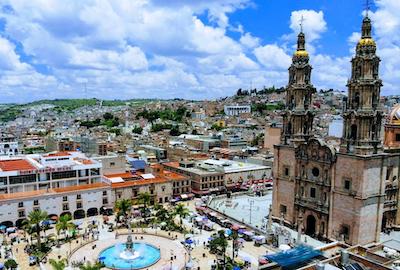
San Juan de Los Lagos
Already in the Altos Norte is this town, famous for being a true epicenter of religious tourism. The old, huge and impressive churches do not end here.
We suggest starting the tour with the Cathedral Basilica Sanctuary of the Virgin of San Juan de los Lagos, an 18th century building that houses no less than six paintings by Rubens inside.
Other sanctuaries that you have to know here are: the Temple of Calvario, built with the characteristic pink quarry; the Parish of San Juan Bautista, the oldest of all; the Temple of the Sagrada Familia, an impeccable neoclassical building and the Parroquia de la Sangre de Cristo.
Lagos de Moreno
Place of houses, temples and parishes as old as Catholicism in Mexico.
Lagos de Moreno is the cradle of poets, historians, artists and even figures of the Independence such as the insurgent Pedro Moreno. The old Capuchinas convent, the Residence of the Count of Rul, the El Calvario Temple and the Temple of La Merced are some of the places of interest.
Union de San Antonio
The taste of Charrería in Mexico. This municipality of Los Altos de Jalisco was already populated since pre-Hispanic times and the town was founded between the years 1770 and 1771, originally called the estancia, later it would have different names until it reached the current Unión de San Antonio.
San Diego de Alejandria
Beginning and end of the Cristero movement in Mexico. This population is characterized by being considered the origin of the armed Cristero movement in Mexico, a very special place to visit, for those who like religious tourism, its history as a town begins in the middle of the year 1680 approximately. Upon reaching the town, the first thing you will see is the monumental gate to Jalisco. Here, on December 31, 1926, the first Cristero movement took place.
Villa Hidalgo
This town in the Altos de Jalisco is known for having huge clothing shopping centers, at a good price. If you are a shopping lover and your family is also the ideal place to satisfy your clothing shopping addictions.
It also has some dams and ecotourism centers for those who like to share in the middle of nature, there is adequate hotel infrastructure, due to the large number of people who come from northern Mexico to do their shopping.
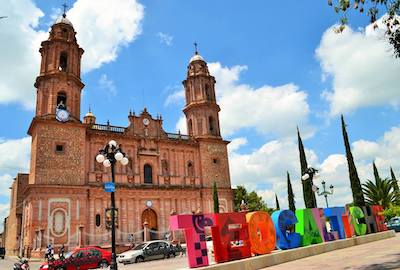
Teocaltiche
The history of Mexico between architecture and crafts. This population has antecedents from pre-Hispanic times, and has a significant amount of historical buildings in proportion to their size.
If you like adventure tourism and exploration, you should not lose sight of the Sierra del Rosario. Among the crafts include sarapes, bone chess, wooden toys and hats. Little hotel infrastructure, at reasonable prices.
Encarnación de Díaz
Also known as the golden gate to the Altos de Jalisco, it received its name because in 1753 an image of the Virgin was found.
In the Mummies Museum there is the smallest in the world and there are a lot of mummies with incredible anecdotes, so it is worth the visit. Another place to visit is the San José museum.
It has a large number of spas and good restaurants to delight in its excellent cuisine and the bread that is made today in the old fashion. Among the crafts stand out the stained glass windows, as well as its pottery and textiles.
More of Guadalajara Surroundings:
More Tourist Attractions in JALISCO
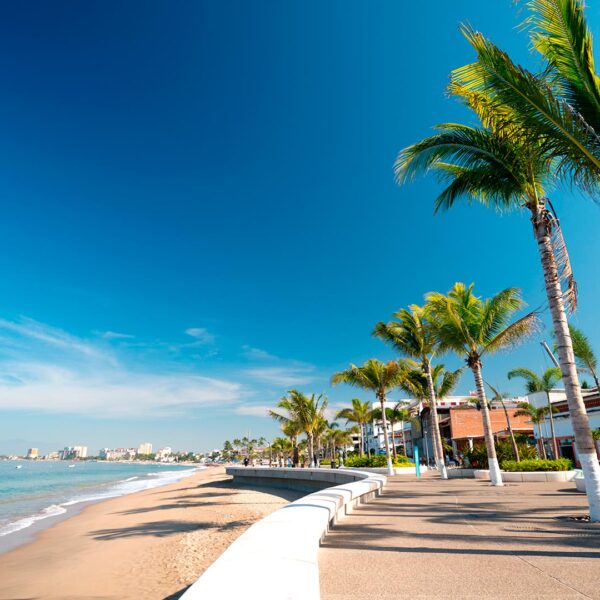
Puerto Vallarta
Located in the Bay of Banderas, in the state of Jalisco, the city of Puerto Vallarta is considered the second most important tourist destination in the Mexican Pacific, its spectacular mountain, beach and mangrove landscapes offer its visitors endless activities and tours. Puerto Vallarta was a traditional town before becoming an international tourist destination. The Spanish conquerors in 1525 named it Bahía de Banderas, based on the name of the culture that had settled here. After the Independence of Mexico it was renamed Las Peñas de Santa María Guadalupe and later shortened to Puerto Las Peñas during the years of the silver mining boom near San Sebastián and Mascota.… Read More

Tequila
Tequila is a mixed drink from the 16th century as a result of the syncretism of two cultures: the Mexican and the Spanish. The Mexica never imagined the dimensions that they could reach with the discovery of agave honeys. After the arrival of the Spaniards to Mexico, a new post-fermentation process, distillation, was incorporated, thereby obtaining an innovative liquid: tequila.… Read More
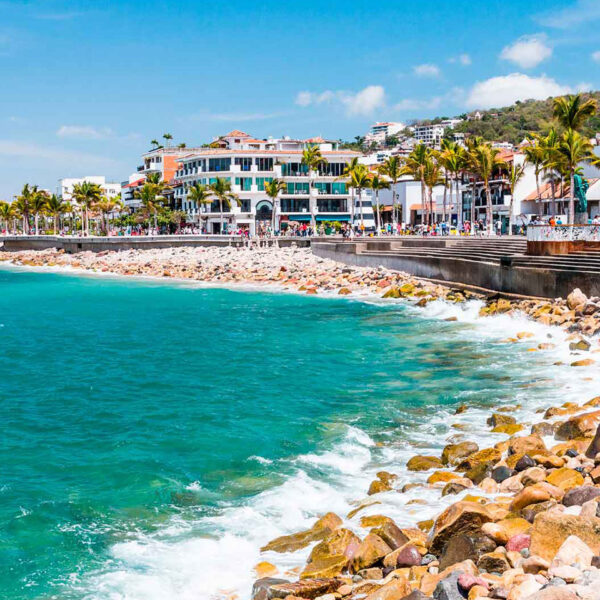
Beaches in Jalisco
On the Jalisco beach map, the coastal corridor known as Costalegre stands out, which includes four municipalities: Cabo Corrientes, Tomatlán, La Huerta and Cihuatlán, as well as the coastlines of six bays: Tenacatita, Bahía de Navidad, Costa Careyes , Costa Majahuas, Bahía de Chamela and Cabo Corrientes. All of these are considered among the best beaches in Jalisco. Tourism in Jalisco is one of the largest in Mexico, since this activity attracted almost 22 million national tourists and four million foreign tourists who visited the state during the last year.… Read More
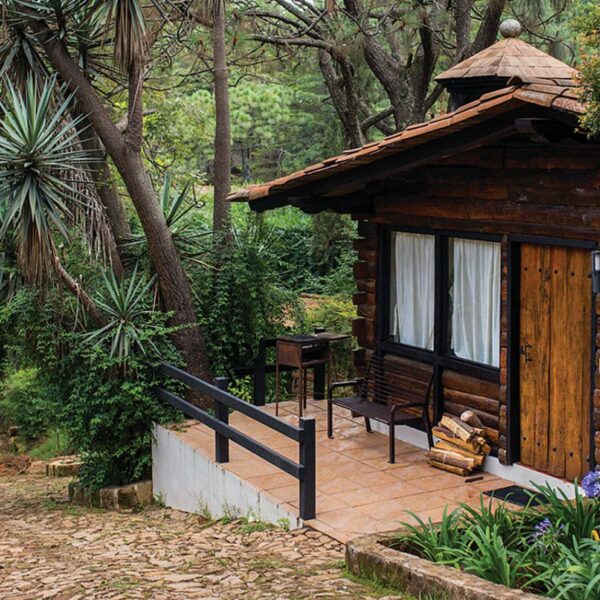
Magical Towns in Jalisco
Jalisco has 8 Magical Towns where you can live unique experiences, enjoying the local gastronomy, the impressive natural landscapes, walks and ecotourism excursions, but best of all, the warmth and hospitality of its people.… Read More
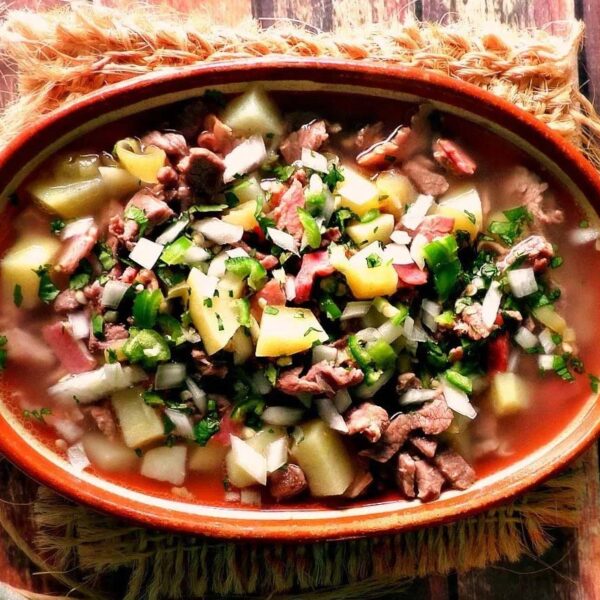
Gastronomy of Jalisco
The state of Jalisco has an amazing diverse and delicious cuisine, it is arguably one of the most traditional regions of Mexico. When Spanish settlers came to the region they introduced several ingredients to the Mexican diet. This fusion of cuisines and ingredients has made Mexican cuisine one of the most extensive and nuanced cuisines in the world. Classic dishes for the area include the Birria, a dish made of beef, goat, or lamb baked in a sauce with several spices, hot peppers, and chopped onion, prepare it is in a barbecue, in a hole in the ground; the pozole, stewlike soup of pork or chicken, hominy, mild chili peppers, and coriander leaves; the pipian, a sauce served as a condiment or marinade sauce for poultry, seafood, pork, and vegetable dishes; tostada de pata, fried tortilla with beef meat; enchiladas tapatías, a corn tortilla rolled around a filling and covered with a creamy poblano chile and tomato sauce; and the famous tortas ahogadas, a sandwich made of a special bread called “birote” (saltier than bread rolls) stuffed with pork covered or “drowned” in a spicy sauce prepared with tomatoes and hot peppers.… Read More
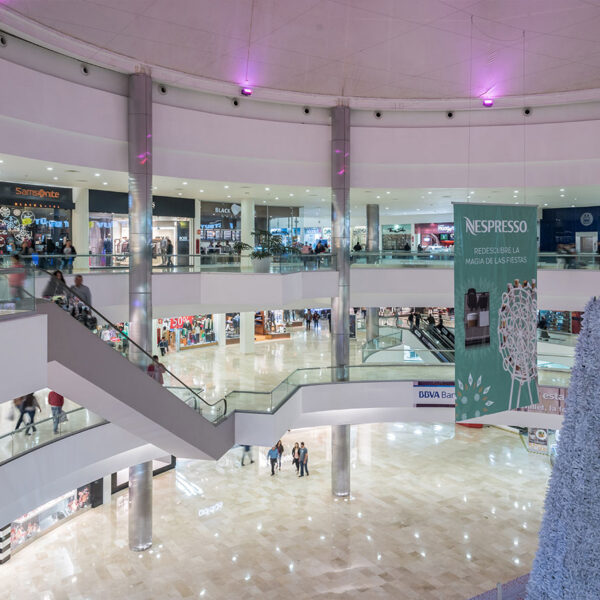
Shopping in Guadalajara
No visit to Guadalajara would be complete without taking time to shop. Whether you need a new pair of shoes, a luxury tailored suit, home décor pieces, or even Mexican spices, Guadalajara is sure to exceed your expectations. Shopping options in Guadalajara are extensive, whether you are looking for footwear, handicrafts, jewelry, sweets, souvenirs, in this guide we try to include options for all budgets.… Read More
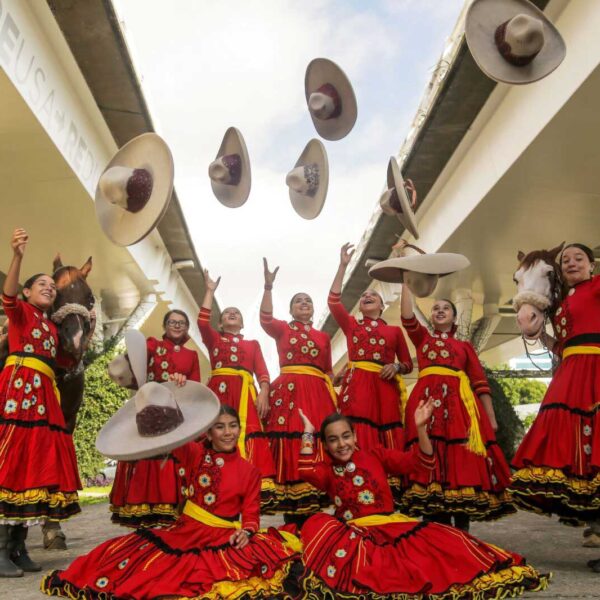
Traditions of Jalisco
Jalisco is full of surprises. A cosmopolitan metropolis modern, but authentic and traditional at the same time. Many of things which are typically associated with Mexico have their origins in Jalisco. These include rodeos called charreadas, mariachis, and of course the tequila.… Read More
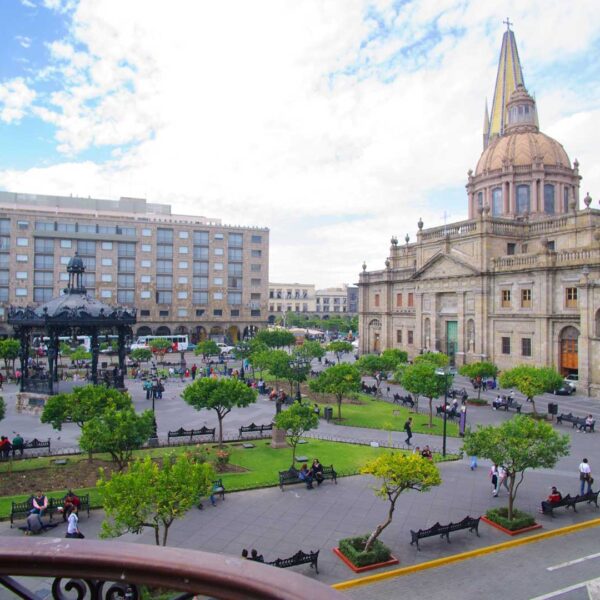
Guadalajara
Guadalajara is the capital of the State of Jalisco and the second largest city of México. It is known worldwide for its folklore, the renowned Mariachi, handcrafts, tequila and the national sport, charrería. Few cities can offer such a variety of interesting things to see and do, involving the visitors in a cultural, historical and legendary atmosphere. You can begin your enchantment by visiting the Historical Center and its magnificent buildings. The rich colonial legacy can be seen all over the city, including the Cathedral, featuring the symbol that has become emblematic of Guadalajara, its towers. Tlaquepaque and Tonalá are located out of the city limit, both towns are worldwide known for the quality and wide variety of its handcraft.… Read More
Guided Tours in GUADALAJARA
Flights & Hotels in GUADALAJARA
More Tourist Attractions in MEXICO

Archaeological Sites
The Archaeological Zones are the cultural past of every Mexican. You will be amazed at the ambient, nature and the environment that surrounds them. Climbing to the top or being around it will take us back in time to admire every detail. México is a country of culture and traditions, many of which we have inherited from the pre-Hispanic inhabitants of this vast territory, although it is true that there were more settlements in the central and southern part of the country, it is also possible to find some archaeological remains in the north.
… Read More

Traditions in Mexico
It is practically impossible to make a meticulous, and above all, accurate selection of the places to visit in Mexico. Each place that our country houses is unique and beautiful in its own way. Mexico, with its nearly 2 million km², has a large number of scenarios to offer, as well as endless activities to do. Do not lose your way and enter the places to visit in Mexico. In Mexico, apart from the beaches and its famous archaeological sites, there are many other really interesting sites and activities that you should know. In the surroundings of the main cities you will find places full of culture and tradition, where you can spend relaxing, interesting and fun vacations. On your trip through Mexico you cannot stop obtaining souvenirs, the crafts that are made here are of the highest quality and recognized worldwide. A shopping tour cannot be missed.… Read More

Ecotourism and Adventure
Mexico is one of the best countries for Ecotourism as it has a great variety of flora and fauna, as well as a large number of refuges for extraordinary species. You can enjoy recreational activities of appreciation and knowledge of nature through contact with it, such as: stargazing, observation of natural attractions, wildlife and bird watching. Throughout México there are more than 176 protected natural areas, 5 of them considered by UNESCO as Natural Heritage of Humanity. Just for this and much more, we believe that Mexico is a Paradise for Ecotourism.… Read More

Capital Cities
Folklore, gastronomy, literary culture, art and exhibitions, is what you will find in the capitals of the states of Mexico. To the north, colonial Mexico, Puebla, Guadalajara, Guanajuato, the Sonoran desert and the California peninsula. To the east Veracruz and the gulf. To the west Acapulco, Oaxaca and Tuxtla Gutiérrez. And to the south the Riviera Maya and the pyramids of Chichén-Itzá, Tulúm and Cobá in Yucatán, Palenque in Chiapas, the cenotes, and the Central American jungles.… Read More

Magical Towns
A Magical Town is a place with symbols and legends, towns with history that in many cases have been the scene of transcendent events for our country, they are places that show the national identity in each of its corners, with a magic that emanates from its attractions ; visiting them is an opportunity to discover the charm of Mexico. The Magical Towns Program contributes to revalue a set of populations in the country that have always been in the collective imagination of the nation and that represent fresh and varied alternatives for national and foreign visitors. A town that through time and in the face of modernity, has conserved, valued and defended its historical, cultural and natural heritage; and manifests it in various expressions through its tangible and intangible heritage. A Magical Town is a town that has unique, symbolic attributes, authentic stories, transcendent events, everyday life, which means a great opportunity for tourist use, taking into account the motivations and needs of travelers.… Read More

States Of Mexico
Mexico has an incredible diversity of landscapes, where the beauty of its beaches, internationally recognized, stands out. In its vast territory of coasts, there are beaches of unparalleled beauty, and colorful landscapes. A large network of first-class hotels and tourist services is available to visitors to these beaches. Mexico is also mystical places, dotted with archaeological testimonies inherited from its original inhabitants. Monuments made by the Mayas, Aztecs and Toltecs are located in magical landscapes, like lighthouses in an ocean of natural beauty. They offer visitors buildings that tell their history, and museums that collect their cultural heritage. And that keep alive ancestral traditions, in ceremonies and festivals, where you can enjoy cultural activities and entertainment.… Read More

Beaches
On the Beaches of Mexico you can immerse yourself in the intense blue ocean of the Pacific bays, sunbathe on the shore of the warm and transparent waves of the Caribbean Sea in Quintana Roo or even rest on the beautiful coasts of the Gulf of Mexico. Mexican beaches hide wonderful secrets for the traveler. By visiting them, in addition to enjoying the excellent climate and water activities, you can discover splendid archaeological sites and interesting colonial cities without traveling long distances.… Read More

Gastronomy
The Gastronomy of Mexico has a great diversity of typical dishes, which is why it was recognized by UNESCO as Intangible Heritage of Humanity. The basic and representative ingredients of Mexican dishes are: corn, coriander, chili, beans, piloncillo, nopal and tomato. Mexican cuisine is also characterized by its sauces, which serve as an accompaniment to traditional dishes, prepared based on spices.… Read More


